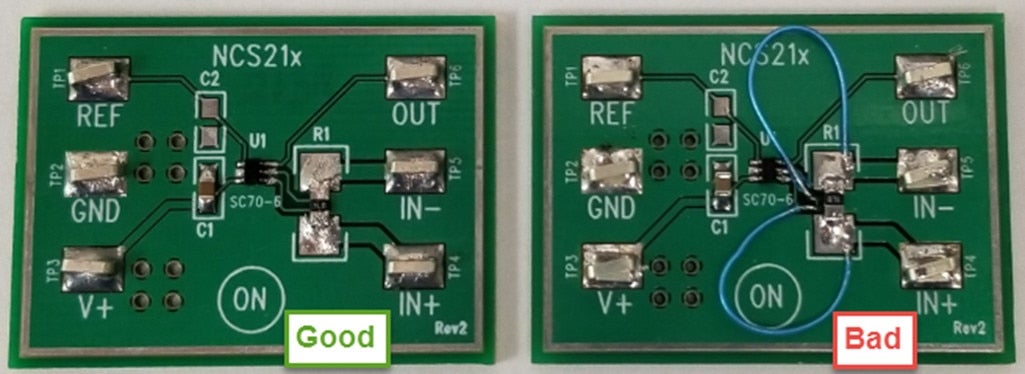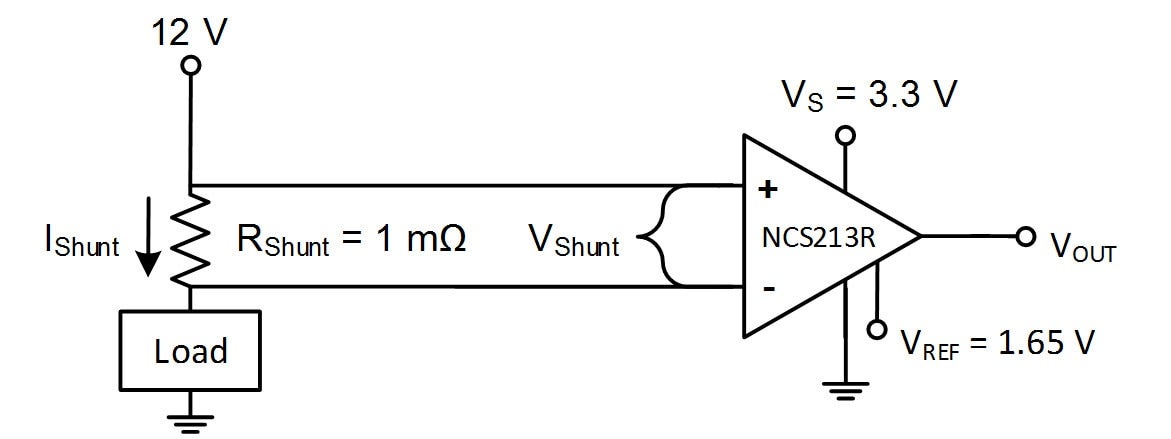This blog is the last blog in a three part series on the topic of shunt resistor connections where the second blog discussed making accurate connections and the first discussed diagnosing errors.
Today, we are going to look at the shunt resistor connection of a PCB design and compare measurement accuracy data between a PCB with a good connection and a PCB with a bad connection.
When making a shunt connection use recommended connections to the shunt resistor. The connection traces should be of equal length, equal dimension and as short as possible. Be sure to ensure the current sense amplifier and the shunt resistor are on the same side of the PCB. For the highest level of accuracy use four terminal shunts also know as Kelvin shunts.
In Figure 1 below, the green box surrounds the area of the sense line traces from the shunt resistor to the input pins. The traces leading to the resistor pad are of equal length, dimension and they terminate at the center of the inside of the pad relative to where the shunt resistor connects to the pad.
Figure 1: NCS21xR Customer Evaluation PCB Layout with Optimized Connections to Shunt Resistor
Figure 2 shows the two customer evaluation boards used for this current shunt measurement experiment. The board on the left, labeled “Good” has a 1 mΩ shunt soldered neatly across the resistor pads (R1) and the sense line connections are optimized based on typical manufacturer recommendations on how to connect to a two terminal shunt.
The board on the right, labeled “Bad” is configured exactly the same as the “Good” board, with the exception of the connection of the sense traces to the shunt. To illustrate the undesirable effects of an incorrect shunt connection, the sense lines were simply cut and rerouted to a different location on the sense resistor pads to emulate an incorrectly designed PCB board connection.
Figure 2: NCS213R Customer Evaluation Board; Good vs Bad Shunt Connections
For the most accurate voltage measurement across IN+ and IN-, use fine tip probes so that the actual input pins can be touched down upon. For accurate measurements on the shunt; since the exact location of the connection is underneath the shunt and is inaccessible, take the measurement on top of the shunt directly above the correct location shown in CSA Part 2: Making Accurate Shunt Resistor Connections.
Figure 3: Schematic of NCS213R test circuit. The output quiescent voltage is 1.65 V
The measurement data in Table 1 was taken using the evaluation boards pictured in Figure 2. The current sense amplifier used was the NCS213R along with a 1 mΩ shunt resistor; see Figure 3 for circuit schematic. In Table 1, notice the “Measurement Error (%)” column for the “Good” connection – the measurement error from the ideal output voltage to the measured output voltage is very small, around one tenth of one percent; likewise, the difference in measurements directly at the input pins compared to measurements directly across the shunt are small, at most slightly over 0.1%. However, the “Bad” connection measurements show the error at almost 1.5% at 1 A and over 10% at 10 A.
Table 1: Shunt Current Measurement Debug Table: Good vs Bad
Table 2 below highlights the NCS21xR and NCS199AxR series current sense amplifiers. Customer evaluation boards for each part number can be ordered at their respective landing pages.
Table 2: NCS21xR and NCS199AxR Series Current Sense Amplifiers
Table 3: NCS213R Customer Evaluation Board (PCB) Bill of Materials (BOM)
The main point of this exercise was to illustrate that sense line connection to the shunt is not trivial and cannot be done haphazardly. It is evident from direct experimentation and observation that the non-optimized sense trace connections introduced unacceptable errors. Also of note on the “Bad” board, are the big discrepancies between the measurements taken at the input pins compared to measurements taken across the shunt. The measurements across the shunt were spot on and as expected, but not so with the measurements directly at the input pins. The voltage at the input pins was higher due to added stray resistance.
For more information about out Current Sense Amplifiers here.






